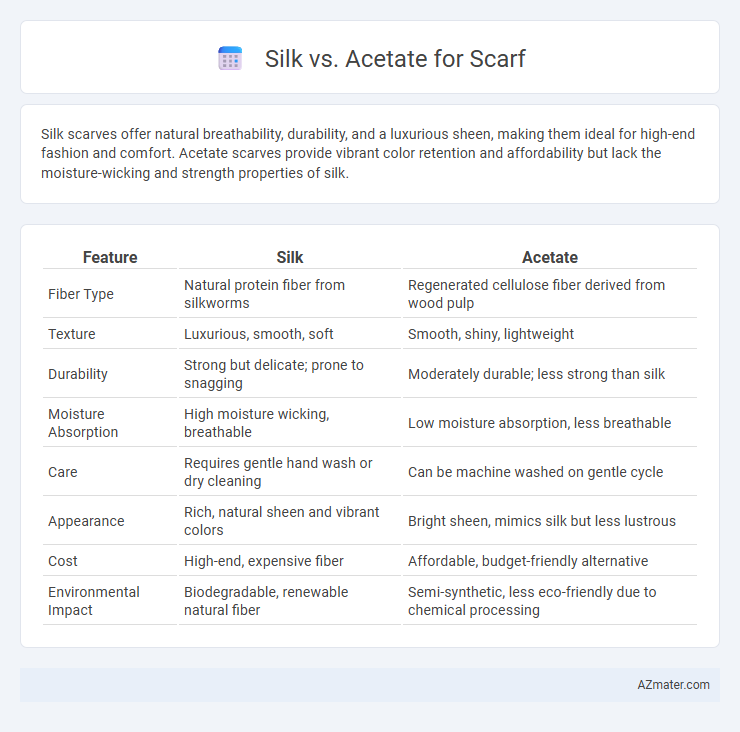Silk scarves offer natural breathability, durability, and a luxurious sheen, making them ideal for high-end fashion and comfort. Acetate scarves provide vibrant color retention and affordability but lack the moisture-wicking and strength properties of silk.
Table of Comparison
| Feature | Silk | Acetate |
|---|---|---|
| Fiber Type | Natural protein fiber from silkworms | Regenerated cellulose fiber derived from wood pulp |
| Texture | Luxurious, smooth, soft | Smooth, shiny, lightweight |
| Durability | Strong but delicate; prone to snagging | Moderately durable; less strong than silk |
| Moisture Absorption | High moisture wicking, breathable | Low moisture absorption, less breathable |
| Care | Requires gentle hand wash or dry cleaning | Can be machine washed on gentle cycle |
| Appearance | Rich, natural sheen and vibrant colors | Bright sheen, mimics silk but less lustrous |
| Cost | High-end, expensive fiber | Affordable, budget-friendly alternative |
| Environmental Impact | Biodegradable, renewable natural fiber | Semi-synthetic, less eco-friendly due to chemical processing |
Introduction to Silk and Acetate Scarves
Silk scarves are crafted from natural protein fibers produced by silkworms, known for their luxurious softness, breathability, and vibrant color retention. Acetate scarves, made from cellulose fibers derived from wood pulp and treated with acetic acid, offer a glossy sheen and affordability while mimicking the smooth texture of silk. Both materials provide lightweight comfort and aesthetic appeal, yet differ in durability, ease of care, and environmental impact.
Origin and Manufacturing Process
Silk, derived from the cocoons of silkworms primarily in China and India, undergoes a natural sericulture process involving manual harvesting and careful reeling to produce fine, lustrous fibers. In contrast, acetate is a synthetic fiber made from wood pulp cellulose that undergoes chemical acetylation and extrusion, commonly manufactured in industrial settings. The natural origin and labor-intensive process of silk yield breathable, luxurious scarves, while acetate offers affordable, shiny alternatives with a different texture and durability profile.
Texture and Feel Comparison
Silk scarves exhibit a smooth, luxurious texture with a natural sheen and exceptional softness that feels lightweight and breathable against the skin. Acetate scarves mimic silk's glossy appearance but tend to have a slightly stiffer, less breathable feel that can feel warmer and less supple. The natural protein fibers in silk provide superior drape and a gentle touch, while acetate's synthetic composition results in a more structured texture with moderate softness.
Appearance and Sheen Differences
Silk scarves exhibit a natural, lustrous sheen that enhances their vibrant colors and intricate patterns, creating an elegant and luxurious appearance. Acetate scarves mimic silk's glossy surface but often appear slightly more reflective and synthetic due to their man-made fiber composition. The subtle difference in texture gives silk a softer, more fluid drape, while acetate tends to hold a stiffer shape with a brighter, more uniform shine.
Durability and Longevity
Silk scarves are known for their luxurious softness and natural strength, offering moderate durability but requiring delicate care to prevent damage from friction and chemicals. Acetate scarves provide a more affordable alternative with a smooth, glossy finish and improved resistance to wrinkling and shrinking, though they tend to be less durable over time due to fiber weakening under prolonged exposure to heat and sunlight. Prioritizing durability and longevity, silk scarves maintain their elegance longer with careful handling, while acetate scarves are better suited for casual use with frequent replacement.
Breathability and Comfort
Silk scarves offer superior breathability due to their natural protein fiber composition, allowing air to circulate and moisture to wick away, enhancing comfort during prolonged wear. Acetate scarves, made from synthetic fibers, tend to trap heat and moisture, resulting in reduced breathability and a less comfortable feel, especially in warm conditions. Choosing silk ensures a lightweight, soft touch with excellent temperature regulation, making it ideal for sensitive skin and all-day comfort.
Care and Maintenance Tips
Silk scarves require gentle hand washing with mild detergent and air drying to maintain their natural sheen and delicate fibers, avoiding exposure to direct sunlight and harsh chemicals. Acetate scarves, while still delicate, can often be spot-cleaned with a damp cloth and mild soap, but should not be machine washed or tumble dried to prevent fabric damage and loss of texture. Both materials benefit from proper storage in a cool, dry place away from sharp objects to prevent snags and preserve scarf longevity.
Price and Value Considerations
Silk scarves often command higher prices due to their natural fiber quality, luxurious texture, and durability, making them a long-term investment with superior breathability and hypoallergenic properties. Acetate scarves, being synthetic, are generally more affordable and offer a glossy finish with vibrant color retention but may lack the resilience and premium feel of silk. When considering value, silk provides lasting elegance and comfort justifying its cost, while acetate suits budget-conscious buyers seeking stylish yet less costly alternatives.
Environmental Impact and Sustainability
Silk production involves natural fibers from silkworms, which is biodegradable but requires significant water and energy resources, raising concerns about sustainability. Acetate, derived from cellulose fibers treated with chemicals, offers biodegradability with a lower environmental footprint due to its quicker processing time and less intensive resource use. Choosing acetate scarves supports eco-friendly fashion through renewable materials and reduced chemical waste compared to traditional silk manufacturing.
Which is Better for Scarves: Silk or Acetate?
Silk offers superior breathability, natural sheen, and hypoallergenic properties, making it the preferred choice for high-quality scarves. Acetate, a synthetic fiber, provides a similar glossy appearance but lacks the durability and moisture-wicking benefits of silk. For luxury scarves with lasting softness and elegance, silk outperforms acetate in both comfort and longevity.

Infographic: Silk vs Acetate for Scarf
 azmater.com
azmater.com